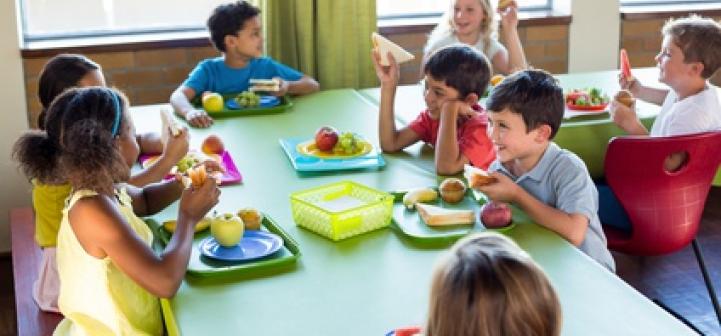
School foodservice directors have great pressures to meet federal, state, and local demands for nutrition, safety, and lunchroom participation. Consequently, the amount of food wasted vs. consumed becomes less of an issue to foodservice operations than does the amount of food prepared and purchased. This leaves food waste as an often overlooked component of healthy consumption. However, we have good reasons to pay more attention to the antecedents and consequences of food waste in our school lunchrooms. Here are some important considerations.
Wasted Food is Wasted Nutrition
A primary reason to care about wasted food in school lunchrooms is nutritional in nature; not surprisingly, much of the waste comes from healthy items. A Harvard Public Health Study[1] revealed 60 percent of fresh vegetables and 40 percent of fresh fruit are being thrown away. If fruits and vegetables are taken but not consumed, then this nutrition is directly wasted. By reducing the amount of food wasted and increasing the amount consumed, of course the beneficial outcome would be improved nutritional intake. This is especially important for our most vulnerable, undernourished students where school foodservice is a primary source of nutrition.
Unintended Effects of Nutritional Policy
Improving students’ nutritional intake is not a new challenge, and much has been done toward improvements. However, there are public policies in place to encourage healthy consumption that may also be unintentionally exacerbating food waste. For example, over half of the nation’s public school students are currently eligible for free or reduced-price meals,[2] and the Healthy, Hunger-Free Kids Act of 2010 requires that each reimbursable meal must include a serving of both fruits and vegetables (the child must take one or the other). Not only are school systems reporting revenue losses of 15% due to this new policy,[3] a study from Cornell/Brigham Young[4] suggests that requiring students to place fruits and veggies on their tray increases waste substantially. In fact, waste may amount to almost $5 million a day across all 31.6 million national school lunch eaters. An important consideration is that the USDA currently reimburses school lunchrooms $3.07 for each free lunch and $2.67 for a reduced price lunch;[5] with 21.5 million free and reduce lunch eaters, the potential daily waste of USDA funds exceeds $16 million if everyone wastes a 75 cent orange or apple.
Profitability is Independent of Consumer Waste
All things considered, the business incentive for a school foodservice director is not in line with food waste reduction; directors are under pressure to get students to buy lunch, not necessarily to eat lunch. School lunchrooms are primarily self-funded in terms of labor and infrastructure, and the number of lunch goers this year determines a school’s USDA food funding next year. So, the question becomes: Is there any business incentive for foodservice directors to reduce food waste? Only if it improves the bottom line.
Some have argued that serving higher quality food would attenuate the waste issue and increase revenue by increasing consumption. However, the federal reimbursement rate is the same for all school districts, and for schools districts like New York City, the price of food is so high that the gap between USDA reimbursement and the actual food cost exceeds a dollar per plate. This makes it exceptionally difficult to increase food quality, especially in lower income areas where free and reduced lunch is more prevalent (because fewer students are paying full plate price, so the reimbursement gap is more difficult to absorb). And, while parents would be thrilled to hear that their children are wasting less food, the increase in lunch price for a higher quality meal may drive more parents to pack their child’s lunch (reducing the rate of lunchroom eaters, thus reducing USDA funding for the following year).
Foodservices need food buyers, and parents need food eaters
 |
| Click to enlarge |
The best solution may be to implement inexpensive yet effective practices that simultaneously reduce waste and encourage consumption of the federally required yet historically wasted fruits and vegetables. Extant research provides evidence that children can be nudged toward fruit and veggie choice and consumption in the lunchroom. For example, food naming and placement in the cafeteria can increase produce consumption by up to 70 percent.[6] Aside from food-focused strategies, seemingly unrelated components of the eating experience can also influence waste and consumption. For example, plate material has been shown to influence waste particularly in school lunchrooms, where disposable plates resulted in more food wasted than did permanent plates.[7] On the flip side, permanent plates resulted in more food taken and consumed from a buffet line. This result points to an important consideration for foodservice directors – that lunchroom serveware can be influential in both waste and consumption. The caveat is that permanent serveware comes with its own necessary costs, labor, and storage, so directors would need to consider the tradeoffs of costs for disposable vs. permanent items. Additionally, there is evidence to support that pre-meal activities can be influential; for example, extending the lunch period (from 20 to 30 minutes) or having recess before lunch can reduce plate waste by 30 percent or more[8]. These are just a few solutions that might reduce lunchroom food waste without negatively impacting profitability, require little to no adaptation in food policy, and encourage consumption of healthy items.
Contributor
Sara Williamson, PhD, St. Joseph’s University
[1] (2014). New school meal standards significantly increase fruit, vegetable consumption Harvard, School of Public Health.
[2] Rich, Motoko (2015). Percentage of Poor Students in Public Schools Rises. The New York Times.
[3] Murphy, Kate (2015). Why Students Hate School Lunch. The New York Times.
[4] Just, David, and Joseph Price (2014). Default options, incentives and food choices: evidence from elementary-school children. Public Health Nutrition.
[5] National School Lunch Program. Food Research & Action Center.
[7] Williamson, Sara, Lauren G. Block, and Punam A. Keller (2016). Of Waste and Waists: The Effect of Plate Material on Food Consumption and Waste. Journal of the Association for Consumer Research.
